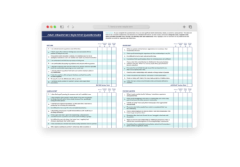As we go about our daily lives, we all experience challenges that test our resolve. While some obstacles are manageable, others can overwhelm us or knock us off course entirely.
Resilience helps us bounce back from adversity, adapt to change, and maintain our well-being in stressful times. Understanding and managing our body’s natural stress response is crucial for building resilience.
When we sense a threat––real or imagined––our body automatically activates a series of physical and psychological changes for protection. But frequent or intense triggering of this response can harm our mental and physical health.
By learning to recognize and calm our threat response, we can build greater resilience and widen our “window of tolerance”—our ability to handle stressful situations in the future.
Let’s explore the threat response system, the window of tolerance, and strategies for building long-term resilience.
Share this Article:
Top Picks for You:
- The Four Attachment Styles: Secure, Avoidant, Ambivalent, and Disorganized
- Toxic Shame: What Is It & What to Do About It
- The Power of Trauma-Informed Care: Understanding What Happened to You
- Somatic Resilience: Overcoming Early Trauma (with Peter A. Levine, PhD)
- Neuroplasticity: Rewiring the Traumatized Brain
Tips for Building Resilience: Calming the Threat Response
Understanding the Threat Response System
Our threat response system is a hardwired survival mechanism that has evolved over millions of years. Known as the “fight, flight, freeze” response, it keeps us safe by reacting to environmental threats. When our brain perceives a potential threat, it sets off a flurry of physiological changes to prepare our body for action:
- The amygdala, the part of the brain that processes emotions, sounds the alarm when it detects a threat (usually through our external senses).
- The hypothalamus, the brain’s “command center,” communicates with the rest of the body through the autonomic nervous system.
- The sympathetic nervous system activates, releasing stress hormones like adrenaline and cortisol.
- These hormones cause physical changes: increased heart rate, rapid breathing, and increased blood flow to the muscles, preparing us to fight, flee, or freeze in response to the perceived threat.
This response helps us navigate dangerous situations. However, problems arise when the brain mistakes everyday stressors—think an email from your boss, getting stuck in traffic, a conflict with your partner—for life threatening situations.
This is common for trauma survivors, as the brain “overworks” to keep us safe, potentially leaving us stuck in a chronic defensive state where even small events feel overwhelming.
Chronic stress and overwhelm can lead to various mental and physical issues, including:
- Anxiety and mood disorders
- Cardiovascular issues
- Weakened immune system
- Digestive issues
- Sleep disturbances
- Cognitive impairment
Understanding how the threat response works is the first step in managing it more effectively. Next, we’ll explore the window of tolerance and its role in processing and coping with stress.

The Window of Tolerance
The window of tolerance is a concept developed by psychiatrist Dr. Dan Siegel. It refers to an optimal zone of emotional and physiological activation that allows us to function effectively in everyday life.
When we’re within our window of tolerance, we feel calm, centered, and capable of handling challenges. We think clearly, regulate emotions, and respond appropriately to situations.
Stress, trauma, or imminent threats can push us outside this window into hyperarousal (fight/flight) or hypoarousal (freeze).
Hyperarousal is characterized by:
- Overwhelming emotions
- Racing thoughts
- Increased heart rate and breathing
- Agitation or restlessness
- Panic or anxiety
Hypoarousal, on the other hand, is marked by:
- Emotional numbness or disconnection
- Fatigue or lethargy
- Difficulty concentrating
- Feeling “spaced out” or dissociated
- Depression or hopelessness
When we’re outside our window of tolerance, we struggle to cope with stress. We may feel overwhelmed, reactive, or shut down, making even minor challenges more difficult.
Other signs include:
- Irritability, defensiveness, or paranoia
- Difficulty concentrating or making decisions
- Intense mood swings
- Impulsive or self-destructive behaviors
- Feeling disconnected from ourselves or others
The good news is we can learn to widen the window of tolerance and build greater resilience. By practicing strategies to calm our threat response and regulate our arousal levels, we can spend more time in this optimal zone.
When working optimally, the threat response is short-term. Once the stressful situation passes, we need to complete the stress cycle to return to equilibrium.
Completing The Stress Cycle
In our fast-paced lives, we often move from one stressor to the next without giving our body and mind the opportunity to fully process and recover from the stress response. This can lead to an accumulation of stress hormones and tension in the body, keeping us in a state of heightened arousal and making it more likely for us to feel overwhelmed by the next perceived stressor.
To prevent this accumulation of chronic stress and its negative effects, it’s helpful to engage in activities that help close the stress cycle. This signals to our body and mind that the threat has passed, allowing us to return to a state of calm and relaxation.
Here are some effective methods for closing the stress cycle:
- Physical activity or exercise
- Raises heart rate and moves the body, tricking the brain into thinking we’ve “escaped” the stressor.
- Releases endorphins, reduces muscle tension, and regulates stress hormones.
- Even short bursts of movement throughout the day can be beneficial—try chair yoga at your desk or take a walk around the block on your lunch break.
- Creative expression and hobbies
- Creative activities allow us to relax by not being goal-oriented.
- Try writing, playing music, painting, or other crafts that bring you joy and let you express yourself.
- Social connection
- Sharing our stress with supportive others is remarkably healing. Reach out to friends and loved ones for support and connection, and provide the same in return.
- Relaxation techniques
- There are numerous ways to promote relaxation and regulation to calm the stress response.
- Engage the parasympathetic nervous system—our “rest and digest” state. This can be done through deep breathing, mindfulness meditation, or muscle relaxation techniques.
Closing the stress cycle reduces the risk of chronic stress and its associated health problems. It’s an ongoing process, so find activities that resonate with you and easily integrate into your routine. Consistent practices help build long-term resilience and improve overall well-being.

Building Long-Term Resilience
While completing the stress cycle manages short-term stress, building resilience is crucial for maintaining overall well-being and widening the window of tolerance. Resilience, the ability to adapt and recover from difficult situations, can be strengthened over time.
Here are some key strategies for building long-term resilience:
- Developing a regular self-care routine
- Don’t relegate self-care to the bottom of your to-do list. Prioritize self-care, including quality sleep, a balanced diet, and activities that “fill your cup.”
- Self-care looks different for everyone, so find what works for you. For some, it might be cozying up with a good book, and for others, it might be attending a music concert or visiting an art gallery.
- Cultivating a growth mindset
- Try to reframe challenges and setbacks as opportunities for growth and learning. Celebrate your efforts, progress, and accomplishments along the way.
- Get inspired by others, and cultivate a sense of curiosity and openness to new experiences and possibilities.
- Practice gratitude
- Practice is the important word here—gratitude doesn’t always come naturally, especially when we feel stressed or overwhelmed by issues and challenges in our lives.
- Consider keeping a gratitude journal, or engaging in gratitude-focused meditations.
- Find joy in simple moments—savor a meal, stop to “smell the roses,” or set aside your phone and truly connect with those around you.
Building resilience is an ongoing process requiring commitment and patience, but the benefits are well worth the effort. Remember, developing resilience is not about avoiding all stress or challenges, but rather building the skills and mindset to cope with them effectively.
When we grow our capacity in this way, our window of tolerance expands, and we find new ways to handle life’s ups and downs.
Building Long-Term Resilience
Resilience is not a destination, but an ongoing journey of self-discovery, learning, and adaptation. By embracing this journey and committing to the practices that support our well-being we can build the resilience necessary to lead a more fulfilling, joyful, and regulated life.
Take a moment to reflect on the strategies and insights shared in this article. Consider how you can integrate some of them into your daily life––and remember to be patient and compassionate with yourself along the way.
With time, effort, and a growth mindset, you can cultivate the resilience needed to weather life’s storms and emerge stronger and more connected to your authentic self.





Ready to Begin Your Healing Journey?
Browse on-demand courses and begin learning from top experts today!


